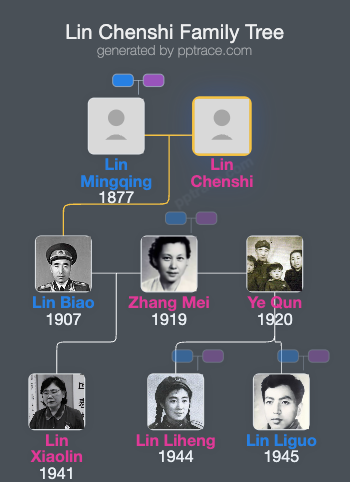
Lin Chenshi
| Name | Lin Chenshi |
| Title | Lin Biao's mother |
| Gender | Female |
| Birthday | — |
| nationality | — |
| Source | https://baike.baidu.com/item/%E6%9E%97%E5%BD%AA/116221 |
| pptrace | View Family Tree |
| LastUpdate | 2025-07-11T09:17:25.310Z |
Introduction
Lin Biao (December 5, 1907 – September 13, 1971), originally named Lin Zuoda, courtesy name Yangchun, pseudonym Yurong, was born in Linjiadawan, Huanggang City, Hubei Province. His family members included his father, Lin Mingqing, and his mother, Lin Chen. He had brothers named Lin Qingfo and Lin Yuju. Lin Biao's grandfather was Lin Shilang. His spouses included Zhang Mei and Ye Qun. He fathered children, including his daughter Lin Xiaolin and sons Lin Liguo and Lin Liheng. His family background carried certain elements of family heritage.
Lin Biao joined the Chinese Socialist Youth League in June 1923 and was admitted to the Whampoa Military Academy in its fourth class in 1925. During his studies, he transitioned from the Communist Youth League to the Chinese Communist Party. While at school, he served as secretary of the Communist Youth League branch of Gongjin Middle School and actively participated in student movements, such as the "September 18 Anti-Imperialist Movement." He initiated the establishment of the "Gongjin Book Club," organized to read progressive books and magazines, and founded the "Gongjin Monthly" publication. After graduating from middle school in autumn 1925, Lin returned to his hometown. His parents initially suggested he become a teacher, but he ultimately decided to abandon teaching and pursue a military career. Approved by the CCP organization, he traveled south to Guangzhou to study at Whampoa Military Academy, adopted the name Lin Biao, and became a non-party military student, serving as the CCP branch secretary.
After graduation, he participated in the Northern Expedition, initially serving as a probationary platoon leader in the National Revolutionary Army and taking part in battles at Shangcai and Linying. In July 1927, he participated in the Nanchang Uprising, serving as squad leader of the 7th Company, 73rd Regiment. Subsequently, he fought alongside Zhu De and Chen Yi in campaigns across Min, Yue, Gan, and Xiang border regions. In 1928, he participated in the Xiangnan Uprising, serving successively as battalion commander and regimental commander in the Red Army's 4th Army, actively engaging in the anti-"encirclement" campaigns from Jinggangshan Revolutionary Base.
From 1930 to 1934, Lin Biao served as a regimental commander and chief commander in the First Red Army, participating in significant campaigns including the Long March. After the Zunyi Conference in October 1934, he commanded troops in battles such as crossing the Red Water (Chishui River) four times and skillfully crossing the Jinsha River, demonstrating outstanding military leadership. In 1936, he was appointed president of the Chinese Anti-Japanese Red Army University, concurrently serving as president of the Anti-Japanese Military and Political University and as political commissar.
During the Second Sino-Japanese War, Lin Biao was commander of the 115th Division of the Eighth Route Army. He achieved notable victories in the Battle of Pingxingguan and was one of China's key military commanders in the anti-Japanese resistance. During this period, he established bases and organized campaigns in northern Shanxi and Luliang regions, showing strong battlefield command capabilities. In 1942, he went to the USSR for medical treatment, then returned to Yan'an to continue party military education work. In 1943, he represented Mao Zedong in negotiations with Chiang Kai-shek in Xi'an and participated in several military operations during the later stages of the war.
During the Chinese Civil War, Lin Biao served as commander of the Northeast Field Army, participating in key battles such as the Liaoshen Campaign, which resulted in the destruction of large amounts of Kuomintang forces and significantly advanced the war effort. After the war, he was appointed First Secretary of the CCP's Central China Bureau and involved in the military buildup of the new People's Republic of China.
Following the founding of New China, Lin Biao held numerous major positions, including Chairman of the Central and South Military and Political Committee, Commander of the South Central Military Region, and leader of the 4th Field Army and Central China Military District. In the 1950s, he moved to Beijing, gradually reducing his workload due to health issues but continuing to hold important positions. From 1954, he served as Vice Premier of the State Council and Vice Chairman of the National Defense Committee, and in 1955, he became a Central Committee Politburo member.
In the 1960s, Lin Biao rose steadily within the CCP hierarchy, becoming a key military leader and participating in the Cultural Revolution. Mao Zedong regarded him as a potential successor. In 1969, he was included as a standing member of the CCP's 9th Central Committee's Politburo Standing Committee and was also Vice Chairman of the Central Military Commission, seen as Mao's designated successor. In 1971, he plotted to seize the highest party, government, and military authority but his conspiracy was exposed. On September 13, 1971, he died in an aircraft crash in the Wutundun region of Mongolia, after his plane was destroyed.
Lin Biao's military career was focused on China’s revolutionary war, the Second Sino-Japanese War, the Chinese Civil War, and the establishment of the People's Republic of China. His political career peaked during the Cultural Revolution but ended due to political events. In 1973, the CCP expelled him from the Party; in 1981, the Supreme People's Court recognized him as the primary criminal in an anti-revolutionary group case.
Family Tree
Tap to expand more relatives
